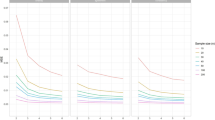Abstract
The aim of this paper is to derive methodology for designing ‘time to event’ type experiments. In comparison to estimation, design aspects of ‘time to event’ experiments have received relatively little attention. We show that gains in efficiency of estimators of parameters and use of experimental material can be made using optimal design theory. The types of models considered include classical failure data and accelerated testing situations, and frailty models, each involving covariates which influence the outcome. The objective is to construct an optimal design based of the values of the covariates and associated model or indeed a candidate set of models. We consider D-optimality and create compound optimality criteria to derive optimal designs for multi-objective situations which, for example, focus on the number of failures as well as the estimation of parameters. The approach is motivated and demonstrated using common failure/survival models, for example, the Weibull distribution, product assessment and frailty models.
Similar content being viewed by others
References
Atkinson AC (2008) DT-optimum designs for model discrimination and parameter estimation. J Stat Plan Inference 138: 56–64
Atkinson AC, Donev AN (1992) Optimum experimental designs, 1st edn. Oxford University Press Inc., Oxford
Blischke WR, Murthy DNP (2003) Case studies in reliability and maintenance. Wiley series in probability and statistics. Wiley, New York
Casella G, Berger RL (2002) Statistical inference. Duxbury Press, North Scituate, MA, USA
Chaloner K, Larntz K (1992) Bayesian design for accelerated life testing. J Stat Plan Inference 33: 245–259
Clyde M, Chaloner K (1996) The equivalence of constrained and weighted designs in multiple objective design problems. J Am Stat Assoc 91: 1236–1244
Cook RD, Wong WK (1994) On the equivalence of constrained and compound optimal designs. J Am Stat Assoc 89: 687–692
Cramér H (1946) Mathematical methods of statistics. Princeton University Press, Princeton, pp 474–477
Crouchley R, Pickles AR (1995) Multivariate survival models for repeated and correlated events. J Stat Plan Inference 47: 95–110
Danziger L (1970) Planning censored life tests for estimation of the hazard rate of a Weibull distribution with prescribed precision. Technometrics 12: 408–412
D’Argenio DZ (1981) Optimal sampling times for pharmacokinetic experiments. J Pharmacokinet Biopharm 9: 739–756
Duffull SB, Waterhouse TH, Eccleston JA (2005) Some considerations on the design of population pharmacokinetic studies. J Pharmacokinet Pharmacodyn 32: 441–457
Erkanli A, Soyer R (2000) Simulation-based designs for accelerated life tests. J Stat Plan Inference 90: 335–348
Escobar LA, Meeker WQ Jr (1986) Elements of the Fisher information matrix for the smallest extreme value distribution and censored data. Appl Stat 35: 80–86
Escobar LA, Meeker WQ Jr (1994) Fisher information matrix for the extreme value, normal and logistic distributions and censored data. Appl Stat 43: 533–540
Escobar LA, Meeker WQ Jr (1995) Planning accelerated life tests with two or more experimental factors. Technometrics 37: 411–427
Escobar LA, Meeker WQ Jr (1998) Fisher information matrices with censoring, truncation, and explanatory variables. Stat Sin 8: 221–237
Gutierrez RG (2002) Parametric frailty and shared frailty survival models. Stata J 2: 22–44
Hougaard P (1995) Frailty models for survival data. Lifetime Data Anal 1: 255–273
Huang YC, Wong WK (1998) Multiple-objective optimal designs. J Biopharm Stat 8: 635–643
Hwang WT, Brookmeyer R (2003) Design of panel studies for disease progression with multiple stages. Lifetime Data Anal 9: 261–274
Klein JP, Moeschberger ML (2003) Survival analysis—techniques for censored and truncated data, 2nd edn. Springer, Berlin
McGilchrist CA, Aisbett CW (1991) Regression with frailty in survival analysis. Biometrics 47: 461–466
McGree JM, Eccleston JA, Duffull SB (2008) Compound optimal design criteria for nonlinear models. J Biopharm Stat 18: 646–661
McGree JM, Eccleston JA (2008) Probability-based optimal design. Aust New Zealand J Stat 50: 13–28
Meeker WQ, Escobar LA (1998) Statistical methods for reliability data. Wiley series in probability and statistics. Wiley, New York
Meeker WQ, Escobar LA, Zayac SA (2003) Use of sensitivity analysis to assess the effect of model uncertainty in analyzing accelerated life test data. In: Blischke WR, Murthy DNP (eds) Case studies in reliability and maintenance. Wiley series in probability and statistics. Wiley, New York, pp. 135–162
Nelson W, Kielpinski T (1976) Theory for optimum censored accelerated life tests for normal and lognormal distributions. Technometrics 18: 105–114
Nelson W, Meeker WQ (1978) Theory for optimum accelerated censored life tests for Weibull and Extreme value distributions. Technometrics 20: 171–177
Onar A, Padgett WJ (2004) A penalized local D-optimality approach to design for accelerated test models. J Stat Plan Inference 119: 411–420
Shih JH, Louis TA (1995) Assessing gamma frailty models for clustered failure time data. Lifetime Data Anal 1: 205–220
Waterhouse TH (2005) Optimal experimental design for nonlinear and generalized linear models. Ph.D. thesis, University of Queensland
Waterhouse TH, Eccleston JA, Duffull SB (2006) Optimal crossover designs for logistic regression models in pharmacodynamics. J Biopharm Stat 16: 881–894
Woods DC, Lewis SM, Eccleston JA, Russell KG (2006) Designs for generalized linear models with several variables and model uncertainty. Technometrics 48: 284–292
Zhang Y, Meeker WQ (2005) Bayesian life test planning for the Weibull distribution with given shape parameter. Metrika 61: 237–249
Zhang Y, Meeker WQ (2006) Bayesian methods for planning accelerated life tests. Technometrics 48: 49–60
Author information
Authors and Affiliations
Corresponding author
Rights and permissions
About this article
Cite this article
McGree, J.M., Eccleston, J.A. Investigating design for survival models. Metrika 72, 295–311 (2010). https://doi.org/10.1007/s00184-009-0254-3
Received:
Published:
Issue Date:
DOI: https://doi.org/10.1007/s00184-009-0254-3




